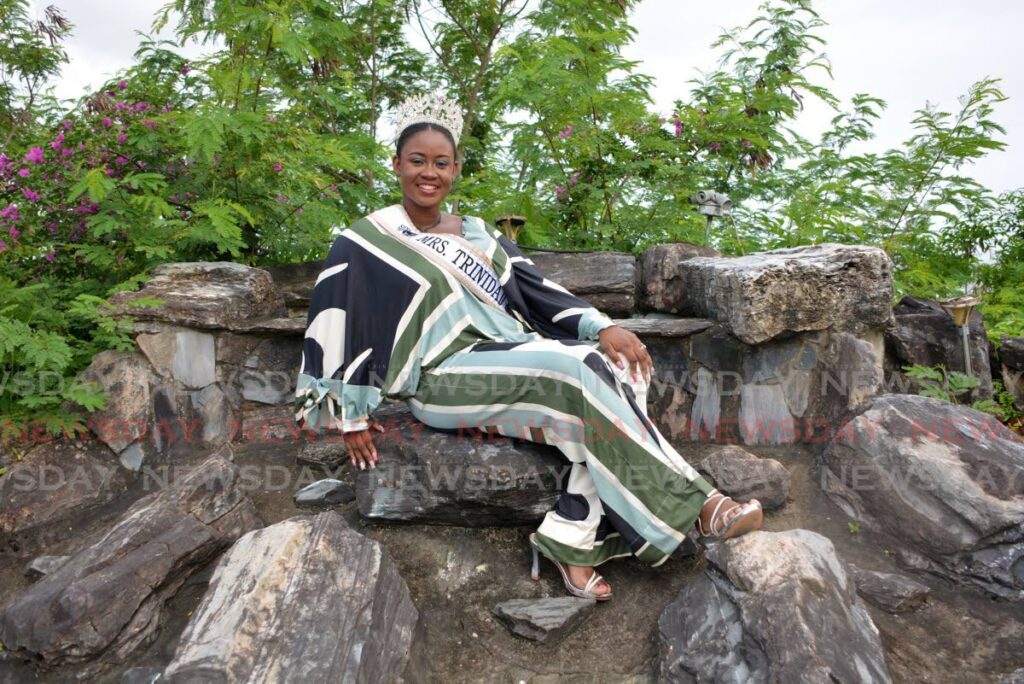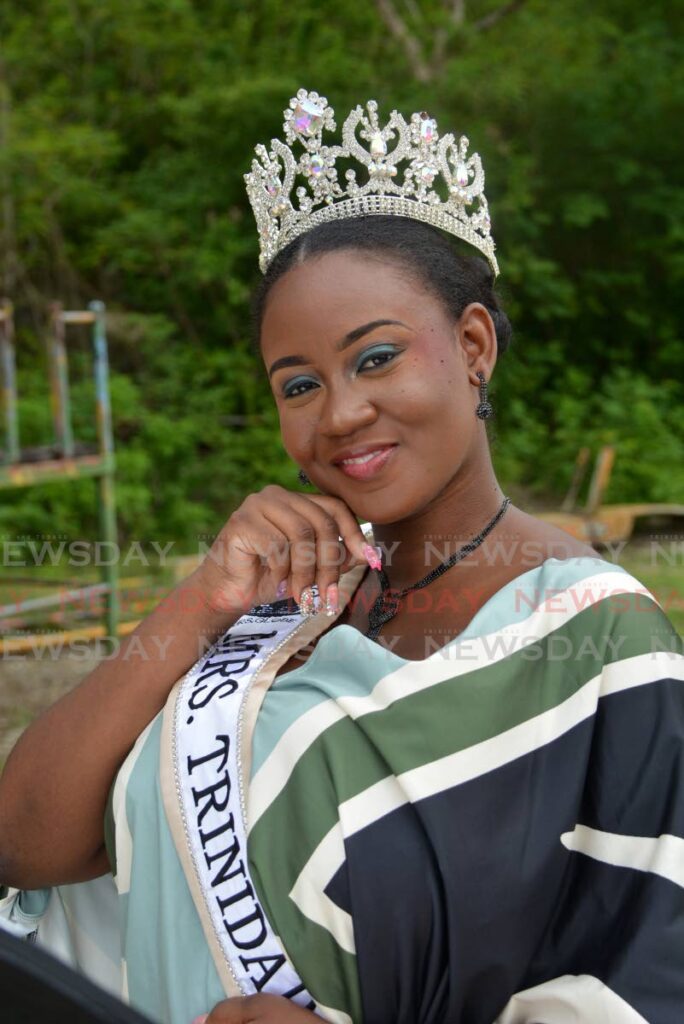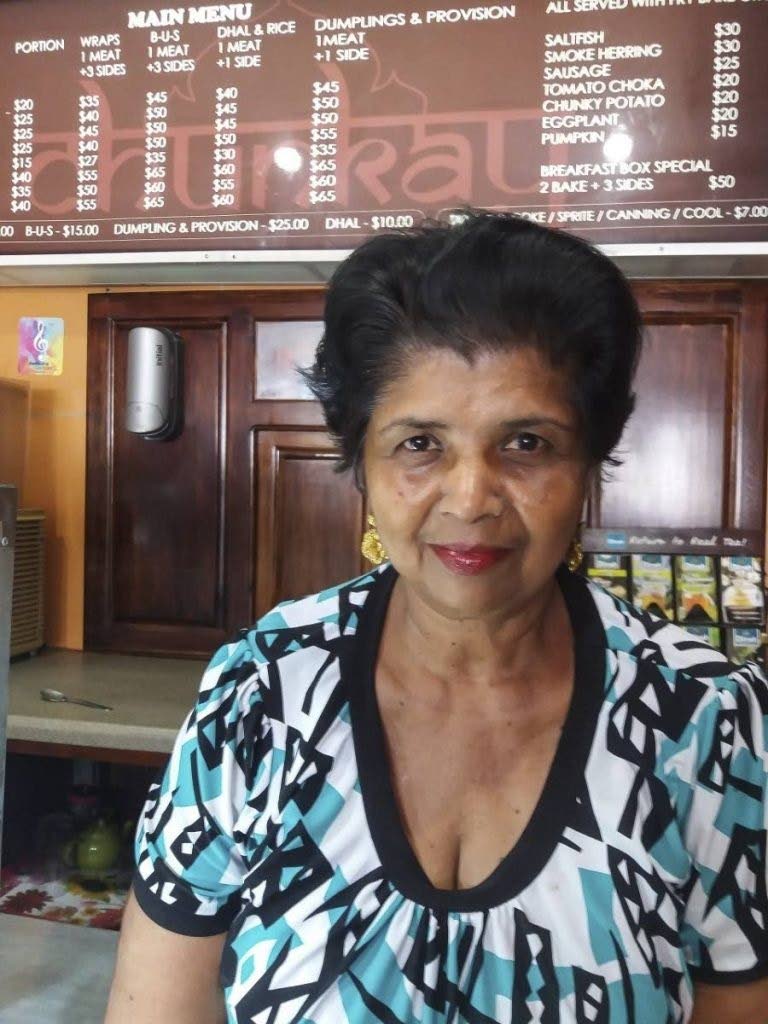|
Shierneil Kimkeran will represent TT at Mrs Globe Curve in Palm Springs, California. - Photos by Innis Francis MOTHER of two, Shierneil Kimkeran is set to represent TT at the Mrs Globe Curve 2025 at Palm Springs in California.
The competition’s key partner in the Mrs Globe organisation is the WIN Foundation, a nonprofit organisation dedicated to helping women overcome abuse and rebuild their lives through empowerment programmes, therapy, and education. This is the first time a representative from TT will take part in the seventh edition of the competition. Kimkeran will begin her journey in hopes of acquiring the coveted title on June 15 for a seven-day stay. The pageant is formed to celebrate the beauty, intelligence, and achievements of married women worldwide. It is held annually, and the pageant emphasises personal development, cultural representation, and community involvement. Kimkeran, like all the other contestants in the competition, would participate in the personality profile, resort wear, costume, and evening gown segments leading up to the big night, when an overall winner would be announced. Kimkeran has a bachelor’s in education and is also a wife and the principal of full gospel online primary school. The 27-year-old prides her accomplishments on the basis of strength; having a strong character to combat the public’s misconception that “nothing good comes from Morvant.” She said: “I started the full gospel online primary school during covid in 2020; to assist parents struggling to adjust to the at-home classes we had no choice but to embrace at that time. We also provide parents with a comfortable faith-based homeschooling option.” The competition runs from June 17 to 22. (Source: Newsday, June 14, 2025)
0 Comments
Honouring Women’s Agricultural Labour is on display at The Art Society. - Photos by Abigail Hadeed HASSAN ALI IT’S easy to forget that history can be observed in the real, tangible things in one’s environment. For example, it can be easy to forget that the Churchill-Roosevelt Highway was constructed because the US Army needed efficient transport between bases – especially when sitting in afternoon traffic. Dr Gabrielle Hosein’s ongoing exhibition – her first ever – at The Art Society, The Botanical Afterlife of Indenture: Imaginative Archives, aims to remind us of some of these histories and address some gaps in Trinidad and Tobago’s story. The show itself is highly collaborative. In May 2023, artists Abigail Hadeed, Risa Raghunanan-Mohammed, Gevena Drepaulsingh, and Chandra Rattan became part of the team producing portraits seen throughout the show. From there on, the team would continue to build and expand. These various contributors were contacted by Hosein to become part of the exhibition. The exhibition begins on viewers’ left once they enter the door. The first piece that’ll greet viewers is an unnamed, unlisted installation, designed by Melanie Archer, consisting of several tables covered in cloth. Atop these tables, various seeds, pods, and grains are placed in bowls or laid plainly on the table. Among these were: neem, moringa, dhal, rice and more. In a gap between one table and another two cocoyea brooms lean against the wall, sweeping-side up. The plants included in this installation are all part of a list written by the late Prof Brinsley Samaroo. The list itemises “flora which were fitted into this jahaji bandal” which accompanied labourers on their journey to Trinidad and Tobago. Besides the plants in the installation, Samaroo’s list also names cucumber (khera), mango (aam), marijuana, caraillee, and various other plants which are now essential parts of Trinidad and Tobago’s diet and cultural identity. Gazing back at photographic history. After the installation, a series of photographs by Abigail Hadeed showing some of the listed plants occupies the wall. Some of the pictures are captured at different phases of the respective plants’ growth. – an agricultural symbol prominently associated with Indo-Trinidad and Tobago identity – they were “kept alive in family plots and in women’s marketing.” While saying this, she points to an archival picture entitled Coolie Vegetable Seller, Trinidad – listed as The Exoticised Vegetable Seller on the show’s catalogue – which features a woman in simple, white garb holding a large cabbage. She says that she chose to include this picture because its subject looked to be obviously on her way to or from the market. The seller looked like she was “pulled off the street…like somebody said come and let me take a picture of you,” said Hosein. Hosein says that after years of scouring archives, she has still found very few depictions of women labouring. When the first group of Indians arrived, there weren’t many women. Hosein says that most women brought over to Trinidad and Tobago, whether they were enslaved or indentured, were brought here to be labourers. Hosein says that women from both groups found themselves on the land working their own plots and gardens (where they were able to obtain them) and taking produce to market. Despite being oppressed under different systems, she says that these historic experiences are things we should all be able to identify with – that they are a meaningful part of our landscape. Besides agriculture, the show also addresses women’s absence from historic archives. As mentioned before, Hosein has hardly found mention of women labouring. Other, less acceptable behaviours are more undocumented than this. Another archival image titled Objectified highlights the sort of media that was commonly produced. The art of henna. The image depicts a woman with one hand against her cheek and the other resting on her lap. She’s in vibrant colours, blue and pink, with much fancier patterns and detailing than the vegetable seller. She has on more jewellery than the seller and is made up with pink blush and lipstick. This is the stereotypical “Coolie Belle” – a woman both exotic and docile. The text beneath the image reads, “Colonial studio portraiture was complicit in the production of this highly circulated stereotype to convey passivity, complicity, leisure, luxury, and an unthreatening femininity.” Because of the general absence of documentation of indentured women who weren’t done up and pictured in the Coolie Belle aesthetic, Hosein thought that she ought to find ways to amend the archive. Unfortunately, it’s not possible to jump back to 1910, snap a couple pictures, and come back home. Instead, Hosein worked with a team to produce original pictures – one of whom was her daughter Ziya Hosein-Livingstone. Cocoyea I and II, Pooyah (cutlass) I and II and Grass Knife I and II all aim to put the tools of various Indentureship-era trades in women’s hands: the grass knife for harvesting rice; a cutlass for chopping and acts of resistance; and a cocoyea broom, not just as a cleaning tool but as a tool which indentured women often fashioned with their own hands. Downed Tools sees the representation of a more militant woman. The subject, played by Hosein, stares at the camera with half-lidded eyes – her gaze loaded with disdain. One hand holds a cutlass, the other holds her hand up in rebellion. The exhibition also features a film directed by Nicola Cross, with sound recording and editing by Lyndon Livingstone and narration by Ziya Hosein-Livingstone. The film shows picture and video submissions of people sharing the plants in their own environment which came across the Middle Passage as a result of Indentureship – a demonstration of the presence of botanical histories in our contemporary landscape. Jewellery that tells stories. Following the film, there are more images. This time, they’re of mehndi done by Risa Raghunanan-Mohammed. At first, they seem like any other mehndi – beautiful and intricate – but upon closer inspection viewers will notice that the subjects and symbols used in the art aren’t the usual stock. In Mehndi Landscape, we see a sprawling field, flowers, women at work, and a lone schoolgirl walking down a rural road. Mehndi, most commonly seen in Trinidad and Tobago at Indo-Trinidad and Tobago weddings and around Divali-time, is commonly used for decorative, beautifying purposes. Generally speaking, it’s not conceived of as an archival medium. There are some very practical reasons for this: most notably, both the ink and the medium (skin) are temporary. The pictures in the show will go on to be archival but the henna will leave. Around cultural holidays in Trinidad and Tobago, people of all ethnic groups will wear the appropriate garb (if they feel so moved). We view this as an essential part of being from Trinidad and Tobago. The henna, here, functions similarly: it’s a way of wearing one’s history – specifically these untold stories – as proudly as we engage in lighter forms of remembrance. Hosein says that in her time researching henna for the show, she was unable to find henna which attempted this style and story. Keeping with the theme of temporary art, a set of 11 temporary tattoos designed in collaboration with Portia Subran hang on the wall. These tattoos are references to godnas, “tattoos once required of Hindu brides upon marriage.” The designs, however, do not follow this bridal path. Instead, they memorialise women of labour: one is a milk-seller; another tattoo has the scales which Subran’s grandmother used to weigh goods. Mitchum Weaver created a silver bajuband, designed by Hosein. The bajuband, Hosein says, continues the story of that same schoolgirl walking down the rural road. She says the path the school was also a pathway out of labouring for women. The band features rice, women in militant positions (one with a cutlass raised, another with her fist raised), and a book. After education comes advocacy, both personal and societal. A photo of the sacred tulsi plant. - Abigail Hadeed Other pieces include: a coloured-rice Rangoli by Richard Rampersad and jahaji bandals (which were part part of the installation) which were created in collaboration with Lina Vincent, Gaurav Maurya, Dhanya Kolathur and Setika Singh.
Ultimately, Hosein is writing women into the archive where they had previously been erased or omitted. Though investigation and imagination, she is hoping to share truths about the characters of those women who preceded those of today. She refers to her practice, specifically this show, as an example of post-indenture feminism. A very important part of being post-indenture is women’s movement towards greater self-determination. This is something all Trinidad and Tobago can understand. Debates about slavery and indentureship, especially those which aim to put both on opposite ends of a scale, tend to drive separation between our major national ethnic groups. For all the differences in the these twin systems which birthed Trinidad and Tobago, the commonalities tend to be overlooked. Hosein acknowledges that the exhibition lives primarily in the language of the Indo-Trinidad and Tobago experiences and aesthetics. Simultaneously, she insists on Indentureship not just as “what brought Indians” but also as a formative process which shaped our land – an phenomenon essential to the creation of Trinidad and Tobago as we know it. So next time you suck a mango or drink tulsi tea: remember where it came from; and most importantly, remember that it’s a part of your Trinidad and Tobago. The Botanical Afterlife opened at The Art Society on June 10 and will continue until June 21. The The Art Society can be found on Jamaica Boulevard and St Vincent Avnuee, St James. It’s open from Tuesday to Saturday between the hours of 12 pm to 6 pm. Hosein, 51, is a senior lecturer at the Institute for Gender and Development studies. Since 1997, she’s been involved with rapso, spoken word, building Caribbean feminist movements, and writing on Indo-Caribbean feminisms. She’s a prolific writer and editor. Her column Diary of a Mothering Worker has been around since 2012 and currently calls Newsday home. She received the National Medal for the Development of Women (Gold) in 2022. (Source: Newsday, June 14, 2025). The Tall Boy documentary pays tribute to masman Peter Minshall creator of the human-like tubes used in the 1996 Olympic Games in Atlanta. - File photo by Ayanna Kinsale YOU’VE seen them everywhere – at the side of the road getting people’s attention for businesses, at car shows, in movies, in commercials, on videos on the internet – those inflatable human-like figures with arms and body flailing about wildly. But did you know the idea was dreamed up by Trinidad and Tobago’s very own artist and masman Peter Minshall? Very few people do, which is the point of The Tall Boy, the documentary which won best documentary at the 2025 Diversity in Cannes Short Film and Webseries Showcase in Cannes, France on May 19. It was also one of the two films screened on May 21 at the first ever Caribbean Day, hosted by Pavillon Afriques at the Cannes International Film Festival. Simon Baptiste, producer of The Tall Boy, said the documentary was an ode to Minshall, whose work was used by major productions around the world and helped put TT on the map. One of those ways is the tube man, or tall boy as Minshall called it, which he designed for the 1996 summer Olympics in Atlanta, Georgia, USA.  The Tall Boy director Life Garland, left, and producer Simon Baptiste celebrate the win for Best Documentary at the Diversity in Cannes Award Ceremony. - Photo courtesy Simon Baptiste Speaking to Newsday from Athens, Greece via a WhatsApp call on June 4, Baptiste explained Minshall was hired to be the creative director for the opening and closing ceremonies of the 1996 Olympic Games. He designed the tall boys for the closing ceremony but did not have the time to build them himself. The organisers hired a contractor to build his design and the contractor filed for the patent without his knowledge.
When Minshall’s team discovered this, attorneys were hired to take the contractor to court but learned it would be very costly to fight it. Minshall did not have the funds to do so and so the case was dropped. “The fact that he created something that is out of pop culture for the last 30 years and now everyone knows it but no one knows his name, was very unsettling for us. “It’s like seeing something you recognise around the world at huge events, in concerts, in commercials, in TV series and movies, and knowing no one understands the significance of who this originates from or the country whose culture was able to contribute to this space.” Although Minshall created it, he was never included in the patent so he never earned any royalties from the millions of tall boys or tube men sold or used over the decades. “Minshall was never interested in revenge, but if we’re able to spread the word so that when people see it they can identify with it, that it is directly tied to our culture, it would be a great tribute. “When I look at TT and the Caribbean, we are always seen as a tourism destination or associated with Carnival, but there is so little respect given to the massive amount of contributions that come from our islands. “I felt it was really important that we go on this mission to start giving props to those who have really done so much for our arts and culture. We’ve done so much in terms of literature, artistic works that I think its time we started looking at those things and getting people to really pay tribute.” He said director Life Garland did a fantastic job with the film and never gave up despite the many challenges and obstacles in his way. He said the various difficulties were disheartening. So much so the team almost stopped the project a few times, but at those points, something always happened to keep them going. That they continued was fortunate because, not only did The Tall Boy win an award and was screened at the first Caribbean Day, the team was in the process of signing an agreement for the film with a UK distribution firm. A Caribbean Voice Independent of the official film festival, Diversity in Cannes is supported by award-winning actress Viola Davis’ company JuVee Productions, along with the British Film Institute and Screen Australia. It was one of several standalone productions held in Cannes, France around the same time as the official film festival, which took place from May 13-24. Baptiste said some details of the film were not finalised in time to submit the film to the Cannes Film Festival, but the film team was able to do so for Diversity in Cannes. “The reason why they exist is because Cannes (film festival) tends to play to a certain audience that isn’t really about diversity. So knowing there’s something out there set up by these partners is great because it means women, minority groups, etc, who are also working hard to produce great cinema are recognised.” Baptiste said and he was amazed by how focused people were during the screening. “Everyone in that room hung on every word that was being said. You could tell there was an energy in the room in which people really fell in love with the story and, more importantly, wanted to champion TT and Peter Minshall.” He said after three years of hard work it was a beautiful feeling and the team was grateful for the win, which felt even better. Baptiste told Newsday Caribbean Day was championed by Mark Walton and Karine Barclais. It gave filmmakers of the region a chance to grow and improve. He said it was very successful and he was thankful for it. Caribbean Day included film screenings, panel discussions and networking sessions, and brought together film professionals, institutional representatives, creators and those interested in Caribbean culture. It was a chance to showcase Caribbean products to agents, distributors and major filmmakers. “It was so necessary because, in my opinion, there hasn’t really been a voice that represents Caribbean filmmakers at Cannes. This was a chance for us all to be in the same room – TT, Jamaica, Antigua, Barbados, the Dominican Republic, etc – so many of our brothers, sisters and neighbours how had a voice and a lane that we could all travel together and spread the word of who we are, what we’re doing, the advancements we’re making and, more importantly, how we’re working together.” (Source: Newsday, June 8, 2025) A wind turbine in Europe. - Photo courtesy Freepik WHEN it comes to the Caribbean’s energy future, the winds may soon be turning in our favour – quite literally. Speaking on day two of the Caribbean Sustainable Energy Conference at the Hilton Trinidad and Conference Centre, St Ann’s, on June 3, the experts made it clear: the feasibility of wind power in TT and the wider region is no longer a distant concept but an immediate and pressing opportunity. From regional wind maps to real-time measurement technology, and from Europe’s offshore wind economy to TT’s hydrogen ambitions, industry professionals laid out a comprehensive case for wind’s role in reshaping the Caribbean’s energy landscape. The major takeaway was both candid and optimistic: the economics have caught up with the aspiration. Sheena Gosine, energy international relations and affairs adviser to the Minister of Energy and Energy Industries and vice-chair of the Wind Energy Steering Committee, said, “The Caribbean region benefits from its location. “The North Atlantic subtropical high regulates the northeasterly trade winds, and these winds are known for their consistency, moving from the east to the northeast.” Across the region, wind power deployment is gaining momentum. Jamaica has over 40 MW of wind capacity, while the Dominican Republic leads the region with over 200 MW. Barbados has also embarked on a public-private partnership for a 50-megawatt wind farm – the largest in the Eastern Caribbean to date. Geotechnical studies for the site have already been completed. Gosine noted TT’s onshore wind development has begun in earnest, while offshore possibilities are being assessed concurrently. “Our region’s geographic positioning allows for average wind speeds of six to nine metres per second, making the Caribbean ideally suited for offshore wind energy.” A regional offshore wind strategy developed by C3, supported by the European Union, ranked Jamaica and TT as the top two territories for offshore wind development, scoring them out of 85 based on resource availability, infrastructure, spatial planning and market integration. “The only reason Jamaica led by one point is their higher renewable energy integration. By the end of this year, with the TT Solar Project, we are likely to lead,” said Gosine. Economics: The deciding factor While policymakers often cite environmental concerns and climate goals as drivers for renewable energy, Augusto Bonzi, energy specialist with the Inter-American Development Bank (IDB), was unequivocal about what’s truly moving the market. “This transition is really being driven by economics,” Bonzi said. “Decarbonisation matters, but most of this is fundamentally driven by cost competitiveness.” Bonzi presented figures from the latest Lazard levelised cost of energy (LCOE) report, which placed the global average cost for onshore wind between US$27 and US$73 per megawatt-hour – consistently cheaper than fossil fuel options like combined cycle gas plants. Offshore wind costs, while higher, are steadily declining. IDB Country representative Julian Belgrave at the Caribbean Sustainable Energy Conference hosted by the Energy Chamber of Trinidad and Tobago, Hilton Trinidad and Conference Centre, Port of Spain on June 2. - Photo by Jeff K. Mayers “It’s not surprising that project after project is following this trend,” Bonzi added.
Referencing a 13-year trend from the International Renewable Energy Agency (IRENA), Bonzi demonstrated how both onshore and offshore wind have seen remarkable cost reductions, falling well below fossil fuel generation costs globally. In the local context, Bonzi noted that the IDB’s assessment for TT positioned the country to become a regional green hydrogen economy leader – provided that large-scale renewable energy projects, especially offshore wind, are deployed. “You have the infrastructure, you have the international trade, the shipping, the port. So it’s really about taking it to the next level.” Measuring wind On the technical front, Kevin Atwaroo, power systems engineer at National Energy Corporation of TT, described the country’s ongoing wind resource assessment programme. “Our assessments classify TT’s wind potential into two categories: approximately 2.8 gigawatts of onshore capacity and 32 gigawatts offshore,” Atwaroo reported. To quantify these figures, National Energy deployed light detection and ranging (LIDAR) technology – a mobile, laser-based device capable of measuring wind speeds up to 300 metres above ground. “We are sampling data from one-second to ten-minute intervals, remotely accessed through a cloud platform,” Atwaroo explained. The devices, powered by off-grid solar panels and battery backup, are collecting 12 to 18 months of continuous wind data at two pilot sites: Galeota and Waterloo. The first two resource assessment plans are scheduled for completion by Q3 to Q4 of 2026, with two more starting in mid-2025 at Fishing Pond on the northeast coast and Los Iros in the south. “Anyone will tell you: empirical data, measured data equals better planning and faster deployment,” Atwaroo said. The validated data will inform turbine layout, technical feasibility, and bankable energy production estimates for future wind projects. Ports, human capital and opportunity Gosine argued that wind energy development must be supported by port infrastructure, an area in which TT already excels. “TT has the potential to become the logistical hub for Caribbean wind energy deployment,” she said. The Port of Galeota and Point Lisas Industrial Estate were identified as critical assets for assembling, launching and integrating wind turbine structures, much like European ports that serve as hubs for offshore wind in the North Sea. She also pointed out that existing industrial capabilities could be repurposed for offshore wind. “Here at home, TOFCO (Trinidad Offshore Fabrication Company) manufactures jackets and possesses the technical capabilities and workforce to support offshore wind — transferable skills already in place.” Human capital is another decisive advantage. The local energy industry workforce has shrunk from 23,000 in 2013 to just over 8,000 today. “That tells you we have a cadre of experienced personnel available to staff a future offshore wind sector,” Gosine said. Regional and Global Examples Bonzi reminded the audience that successful examples exist within Latin America and the Caribbean. He cited Uruguay’s rapid transition to 98 per cent renewable energy in just 15 years – with wind accounting for 40 per cent – and its ongoing export of clean electricity to Brazil. In Central America, the 1,800-kilometre SIEPAC electricity line interconnects seven countries, balancing fossil and renewable sources across a regional grid. Closer to home, Suriname recently completed its wind resource assessment, and Barbados announced a request for proposals last week for a 60-megawatt wind farm. “These aren’t distant aspirations. They’re happening now,” Bonzi said. He added that the IDB had also supported Chile’s green hydrogen roadmap, leading to private sector bidding for 5,000 megawatts of wind power within three years. The outlook: feasible and necessary The conference’s discussions made it evident that for TT, wind energy is no longer an experimental concept. The financial case is sound, the resources exist, and the supporting infrastructure and industrial capabilities are ready to be mobilised. “The opportunities are here,” Bonzi said. “Every country must chart its own path based on its resources and circumstances – but the regional and global trends are clear.” With capital costs declining, storage solutions advancing, and regional demand for green energy products rising, experts say TT’s window to secure a leadership role in the Caribbean’s renewable energy transition has opened. Whether for decarbonisation goals, economic diversification, or future-proofing its petrochemical sector, wind power offers a feasible, competitive, and increasingly necessary solution. As Gosine put it, “We are not starting from scratch. We are starting from experience.” (source: Newsday: June 5, 2025)  Joshua Regrello poses next to his Pan and the time panel marking the 31 hours in his bid for the Guinness Book of World Records for the longest pan marathon on December 28. - Grevic Alvarado IT’S OFFICIAL! Pannist Joshua Regrello is now a Guinness World Records title holder.
“I am now a Guinness World Records title holder for the longest marathon playing steelpan/steel drums,” he said on a social media post on May 30, confirming that Guinness approved his record-setting feat. Guinness recognised Regrello’s achievement of playing the steelpan continuously for 31 hours back in December. Regrello said, “Months ago, we came together with one mission: to make history through the power of steelpan and unity. Today, that dream is a global record.” He said the journey to official recognition was detailed. “Every requirement was carefully met and every standard upheld. But one thing mattered most to us, that the word steelpan, our national instrument and our pride, was included in the official record title. That representation means everything, and we have accomplished it.” Regrello thanked his intellectual property law consultant, Carla Parris, who, he said, liaised with the Guinness World Records offices in Miami and London. “To everyone who believed, supported near and far, from the early planning to the final note, thank you. We have done it. This is more than a personal milestone, This is a win for steelpan, our culture and our people. This is by all of us, for all of us.” (Source: Newsday, May 31, 2025) A very popular ornament worn by women of indenture and their descendents is the 'kāṛā'. It is a thick metal ornament that resembles the 'berā' worn on the wrist, but thicker with a wider comference to accommodate the diameter of the ankle.
It is no longer seen in the Caribbean as it is no longer en vogue now and possibly because of its cost. However, we still see it in old pictures of indentured labourers and their descendents or in pictures of Hindu history like on the ankles of painting of the monkey god, Hanuman. (Source: Angelo Bissessarsingh's Virtual Museum of Trinidad & Tobago, May 30, 2025 and the Caribbean Hindustani) 2025 Miss World TT Anna-Lise Nanton. - Photo courtesy Agape Focus Photography EXPECTATIONS are high as Miss Trinidad and Tobago Anna-Lise Nanton will vie to become Miss World 2025 at the pageant in India being held on May 31 at 9 am (TT time). The pageant will be broadcast "live" on CNC3 Television. Local franchise co-owner Navin Boodhai told Newsday on May 29 that about 144 dedicated fans of Nanton would be hosted free of charge to watch the event at Imax Cinema at #1 Woodbrook Place, Port of Spain. "At this point in time, we have our technical guys there at Imax just testing it out to make sure everything will work and by the morning we will be advertising on a first-come registration basis." Newsday asked his message to TT heading into the final countdown. Boodhai replied, "I think the message to TT is really one of patriotism. "Anna-Lise doesn't only represent Anna-Lise; she represents TT and everything that is good of TT." He said what was being promoted and celebrated were the aspects of TT that stood out on the global stage. "And that is what she represents for us. "She has take the best training that she could have and the best trainers in TT, she has taken the best stories of TT, our flora, our fauna, our cricket, all of those things.. "She is representing us internationally. All I ask TT is to lend support. "Whether she brings home the crown or not, she is our queen." Boodhai said that fact should be celebrated by the population. "But as we say that, we do think she has what it takes to bring the crown. And that is what we are looking forward to, second only to Giselle Laronde-West, who actually is one of her trainers as well." On May 26 Newsday reported that Nanton has qualified for the quarter-finals due to her amazing performance in several early events. The Miss World Organisation's scoreboard has ranked her in first place with 205 points. Nanton won the Americas and Caribbean region in the Head to Head debate, where she spoke on women's rights plus climate change. She placed first in the world the shuttle run, one of the three events in the sport/fitness category, in which she was globally fourth overall. Nanton was also a “talent finalist” for her aerial acrobatics display. (Source; Newsday, May 30, 2025)  CARIBBEAN filmmakers will take centre stage at the Cannes Film Festival during the first-ever Caribbean Day at Pavillon Afriques on May 21. The event will feature The Tall Boy, a compelling documentary on Trinidadian Carnival icon Peter Minshall, directed by Life Garland and the Curaçao-set drama Double Play by director Ernest Dickerson. A media release said this landmark event will spotlight the dynamic creativity and growing influence of the Caribbean film industry with a full day of screenings, panels, and networking opportunities. Hosted by Pavillon Afriques, the premier space for African and diaspora cinema at Cannes, Caribbean Day is tailored to connect regional storytellers with international producers, distributors, investors, and media executives. The initiative promises to elevate the visibility of Caribbean talent and content in one of the world’s most prestigious cinematic arenas, the release said. Attendees will also engage with leading Caribbean filmmakers, producers, and industry thought leaders through panel discussions, followed by a curated networking session and a celebratory after-party headlined by singer John G. Mark Walton, ambassador for Pavillon Afriques and associate professor at The New School said, “Caribbean Day is a call to industry professionals looking for fresh stories, new talent, and untapped co-production opportunities. “The Caribbean is open for collaboration and ready to take its place on the global film stage.” The initiative also underscores the powerful role of film and television in tourism marketing. “We’re proud to support Caribbean Day at Cannes, which strengthens the bridge between tourism and the creative industries,” said Faye Gill of the Caribbean Tourism Organization. The Jamaica Tourist Board is the official sponsor of Caribbean Day, reinforcing Jamaica’s leadership in regional cultural promotion. Pavillon Afriques founder Karine Barclais emphasised that Caribbean Day is a “natural evolution” in the platform’s mission to showcase global black cinema, the release said. With more than 3,500 professionals from 61 countries attending Pavillon Afriques in 2024, Caribbean Day marks a significant step forward in spotlighting the Caribbean’s rich storytelling tradition and global film potential. (Source: Newsday May 23, 2025) Members of the Tobago Hindu Society dance to tge music of tassa drummers at Indian Arrival Day celebrations in 2024. - PRESIDENT of the Tobago Hindu Society Pulwaty Beepath has one major wish for this year’s Indian Arrival Day observance. She is hoping that significant progress will be made on the organisation’s Hindu temple in Signal Hill, which, when completed will be the first in the island’s history. “We are still in the process of building the temple and anybody wanting to donate anything towards the construction, it will be greatly appreciated because right now we have to get lights, water, windows, doors. So are looking at the end of the year to see how far we will reach with the construction of the temple,” she told Newsday on May 20. The Tobago Hindu Society hosts its annual Arrival Day celebration at the Gulf City Mall, Lowlands, on May 24, from 5 pm-8 pm. It is one of the organisation’s signature cultural events. Pundit Ramdath Mahase is expected to officiate. Indian Arrival Day, observed on May 30, commemorates the arrival of the first indentured labourers from India on the Fatel Razack in May 1845. Beepath said the Hindu Society’s Arrival Day function has been in existence since the organisation was formed in 1992. “We started observing Divali functions and Arrival Day up to this present time. We have been having these things for the many years and we never stopped.” She said the event continues to grow. “Every year, we have more and more people attending the function. So the event is definitely growing. This year, we are catering for about 300 people.” Beepath said the event will feature performances from several artistes, including the Kashmir Indian Orchestra, Archarya Rukminee Holass Beepath, Govinda Ramlogan (Tobago Channa), Beesram Seudath, Mia Beepath, Sanjay Sharma, the Mahatma Gandhi institute for cultural co-operation among others. She said Niall George, assistant secretary, Division of Tourism, Culture, Antiquities and Transportation, is scheduled to deliver an address on behalf of Chief Secretary Farley Augustine. A representative from the Mahatma Gandhi Institute is also expected to address the gathering. Deputy Chief Secretary Dr Faith Brebnor and other members of the THA, including the Minority bench, have also been invited. Beepath, who has been at the helm of the organisation for more than 20 years, said she was pleased to again celebrate such a significant milestone. “The East Indians arrived in this country in 1845 and its 180 years now. There are a lot of East Indians living in Tobago and many of them are going back and forth to Trinidad to work.” She added many of them have joined the Tobago Hindu Society and were actively involved in the organisation and assisting with various projects. Beepath said the organisation’s main goal is to complete the temple. The construction of the temple suffered a setback in January when thieves stole an estimated $40,000 worth of material from the site. Beepath said the society has not yet received an update on the status of the investigation. Workers from the Unemployment Relief Programme, who are helping to construct the building, discovered that about two tonnes of steel and two pallets of blocks were missing from the site when they showed up for work on January 21. The National Commission for Self-Help donated the steel while Almandoz Hardware in Scarborough donated the blocks. The Tobago Hindu Society turned the sod for the temple in February 2022 on four plots of land it got from the former Orville London-led THA administration some nine years ago. Present at the sod-turning were Secretary of Culture Tashia Burris, area representative Nigel Taitt, then India High Commissioner Arun Kumar Sahu, THA presiding officer Abby Taylor and other religious leaders. Beepath told Newsday the project started about two years ago with the assistance of the commission. She thanked the government, THA and the other entities that have assisted so far with the construction of the temple. “Beside the government, we have a lot of private people that contributed immensely and I want to thank everybody for helping it to reach this far.” Regarding its Indian Arrival Day function, Beepath thanked the Tobago business community for its support over the years. “Throughout the years we have been depending on them and up to the present time we have to thank them because they are the ones who really support us.” She said the Division of Tourism and Culture also assisted with funding for the programme. Beepath urged devotees and all others to come out and enjoy the function. Admission is free and meals will be provided. (Source: Newsday, May 21, 2025) Left to Right: President of the Tobago Hindu Society Pulwaty Beepath;Seeta Beepath Combie and Govinda Ramlogan (Tobago Channa) will perform at the Tobago Hindu Society's Indian Arrival Day celebrations on May 24 at Lowlands Mall.
|
T&T news blogThe intent of this blog is to bring some news from home and other fun items. If you enjoy what you read, please leave us a comment.. Archives
June 2025
Categories
All
|


















 RSS Feed
RSS Feed